Turing House students use ICT applications in many lessons, and often for homework. Core school systems are managed internally, and used by everyone. Other student and parent applications are used by specific departments or for specific purposes. Follow the links or scroll down for more information about each system. We aim to keep this page up to date, but if something seems incorrect, please email the school office with details and include a link to this page.
| Core School Systems: | Student Apps: | Parent Apps: |
| School Microsoft ID | Carousel | Involve (Music lessons) |
| Microsoft 365, including: | Doddle | ParentPay |
| Dr. Frost Maths | SchoolCloud (Parent Evenings) | |
| Educake | StudyBugs (Report absence) | |
| Focus on Sound | Sparx (English) | |
| Parallel | General Information: | |
| Pearson Active Learn | Managing Passwords | |
| Bromcom, including: | Seneca | Where to get Help |
| Sparx Reader | ||
| Unifrog |
Core School Systems:
School Microsoft ID
All students have a school Microsoft ID. They use this to log in to computers on the school network with their internal username and password. Students' usernames follow a standard format. For example, Joe Bloggs who started Year 7 in September 2021 would have an internal username of 21bloggs.j and their full Microsoft ID will be 21bloggs.j@turinghouseschool.org.uk.
School Microsoft passwords are usually set in the first Computing lesson in Year 7. Students can reset them at anytime from a school PC by pressing the Ctrl-Alt-Del keys all at the same time and following the instructions that appear. If you are at home, then you will need to email the school office to request a password reset.
Single sign-on: Single sign-on is an authentication method that allows users to sign in to many independent systems using one set of credentials. If students are logged into their school Microsoft account then then they can access many of the applications listed below simply by clicking on a button, without needing to re-enter a username or password.
Microsoft 365
Microsoft 365 (MS365) is a suite of office applications which includes MS Teams, MS Word, MS Excel, MS PowerPoint, MS Outlook and many more.
All students can log into MS365 online via a web browser using their Microsoft ID as defined above, e.g. 21bloggs.j@turinghouseschool.org.uk (the password is the same as the network password that they use to access school computers).
If having trouble logging in, check the sign-in options to make sure they are set appropriately to log you into an organisation/school account rather than defaulting to a personal account. Students can't re-set their password remotely, so they will need to speak to a member of staff if they can no longer access their account, or parents can email the school office.
Microsoft Teams:
After students have logged into Microsoft 365 (as above) they will be able to use the "waffle" icon to access multiple office applications, including MS Teams which teachers often use to communicate with students. They will tell your child if they have set up a Team for their class.
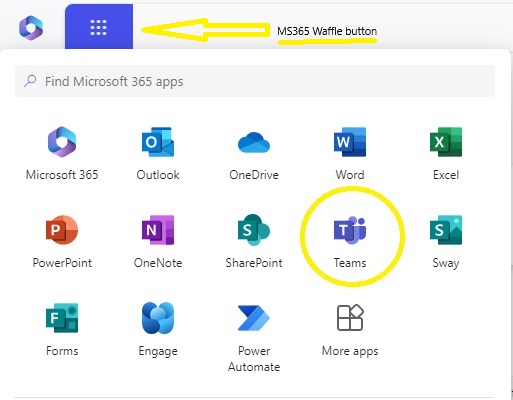 Student
communications via MS Teams are monitored and moderated. Conversations should not be considered private and
any inappropriate usage should be reported to school staff.
Student
communications via MS Teams are monitored and moderated. Conversations should not be considered private and
any inappropriate usage should be reported to school staff.
Microsoft Teams may sometimes be used for remote learning, including live streaming of lessons.
Microsoft Outlook Email:
Once students have logged into Microsoft 365 (as above) they will also be able to access their school email account in MS Outlook.
 Students use MS
Outlook email infrequently because the preferred way for teachers and students to communicate is via MS
Teams. Communications via MS Outlook are monitored and moderated. Conversations should not be considered
private and any inappropriate usage should be reported to school staff. Emails from external addresses are
blocked unless they have been added to the allowed list.
Students use MS
Outlook email infrequently because the preferred way for teachers and students to communicate is via MS
Teams. Communications via MS Outlook are monitored and moderated. Conversations should not be considered
private and any inappropriate usage should be reported to school staff. Emails from external addresses are
blocked unless they have been added to the allowed list.
Students should not use their school email address for anything that they may need access to after they leave the school, e.g. their university applications.
Other Microsoft 365 Applications:
Students can use other MS365 applications such as MS Word (for word processing), MS Excel (for spreadsheets) and MS PowerPoint (for presentations). These applications are used extensively by employers and there are many free tutorials online. Microsoft's own tutorials can be found here.
Installing Microsoft 365 Applications On a home Computer:
If students are using a home computer then, as well as logging into Microsoft 365 applications online via a web browser as described above, they can optionally install desktop versions of the Microsoft 365 applications (Teams, Outlook, Word, Excel, PowerPoint etc) for school use. This isn't necessary, but it can unlock additional features and facilitate continued use of the applications when there is no internet connection.
To download the software, students should log into their school Microsoft 365 account online and click the "Install and more" button which should be in the top right hand corner of the MS365 homepage. Then follow the instructions to download and install the software.
Bromcom
Bromcom is the school's core Management Information System, used to manage many aspects of school administration. Our School ID for Bromcom is 12447.
Bromcom Student Portal:
Bromcom Student Portal is a website where students can see what homework has been set and check their timetable. As long as students are already logged into their MS365 account (see above) they will be able to log into the portal using the single-sign-on button at the bottom of the login screen as shown in the screenshot below.
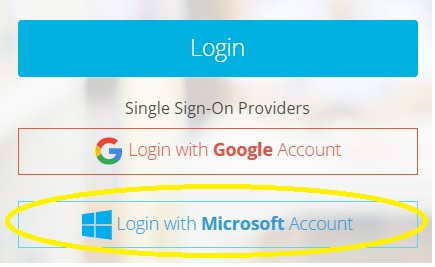
As well as the website, there is a Bromcom Student Portal App that students can install on a phone or tablet. It is available from the usual app stores. Students will need to log in to the app for the first time using these Magic Link instructions, and may be prompted to set up a PIN or biometrics to use for future logins. If the app stops working at any point, try re-installing it.
My Child At School (MCAS):
MCAS is a Bromcom website which provides parents and carers with information about students' attendance and behaviour, homework, reports, as well as most of the messages sent to parents by the school (though some messages may be sent directly to parents' email accounts instead).
To log into MCAS for the first time, parents need to use the email address that they have registered with the school as their username, and follow the instructions in the school's invitation email. You will then choose your own password. Subsequent logins will only need your email address and password. For more information, see the MCAS Parent Guide.
As well as using the website, parents can install the MyChildAtSchool App on a phone or tablet. It is available from the usual app stores. Parents log into the MCAS app for the first time using the same credentials they use for the web version of MCAS. There may be a prompt to set up a PIN or biometrics to use for future logins. If the app stops working at any point, try re-installing it.
Bromcom FAQs:
Homework: If Students have been asked to submit homework via the Student Portal then it will show as complete in MCAS. However, if teachers ask for it to be handed in a different way, or to be completed in a different app, then Bromcom won't record it as complete. Therefore, please don't be concerned if it is showing as "late" in these circumstances.
Troubleshooting Attachments and Links: If you are having problems viewing pdf attachments or web links on MCAS app messages, try the following steps (retrying after each step to see if the problem is resolved):
- Make sure you have the latest version of the MyChildAtSchool app installed - re-install the app if you are unsure;
- Make sure the operating system on your device (e.g. Android/IoS) is up to date;
- For PDFs:
- Open a different pdf document on your device so you can check to see what your default pdf-reader app is. Then make sure that app is up to date too, and clear its data cache (if needed, search online for "how to clear data cache" with the name of the app);
- Consider using a different default pdf-reader (e.g. Chrome, Adobe). If you search online for your device name and the phrase "change default pdf-reader", you should find instructions;
-
For embedded links: look for an option like “Open in browser”, or else copy the link and paste it into Chrome, Edge, or another browser on the phone.
- If all else fails, use the browser version of MCAS instead of the app. You can log into this on your phone, but if you have the same problem with attachments, try it on a different device.
Student Applications:
Dr Frost Maths
All students have Dr Frost Maths accounts to help support their study of Maths. Often teachers will set homework using this platform. There are two different methods for to logging in:
Method 1: Students can log in using their school email address and a password. The first time they log in they will use a default password given to them by their maths teacher. They will then be prompted to set up their own password, which they will need to remember.
Beware: If you mistype the email address, an error message will appear saying the account does not exist. Please do not attempt to create a new account. Try logging in again, making sure your school email address and the password are entered correctly (the instructions and video above should help). Make sure you are not using capital letters, because the credentials are case sensitive.
Method 2: Alternatively, if students are already logged into their school Microsoft 365 account, the easiest way to log into Dr Frost is by single sign-on, using the "Microsoft 365" button, ringed in red in the screenshot below.
If you have tried both methods and still cannot log in, please contact your maths teacher for further help.
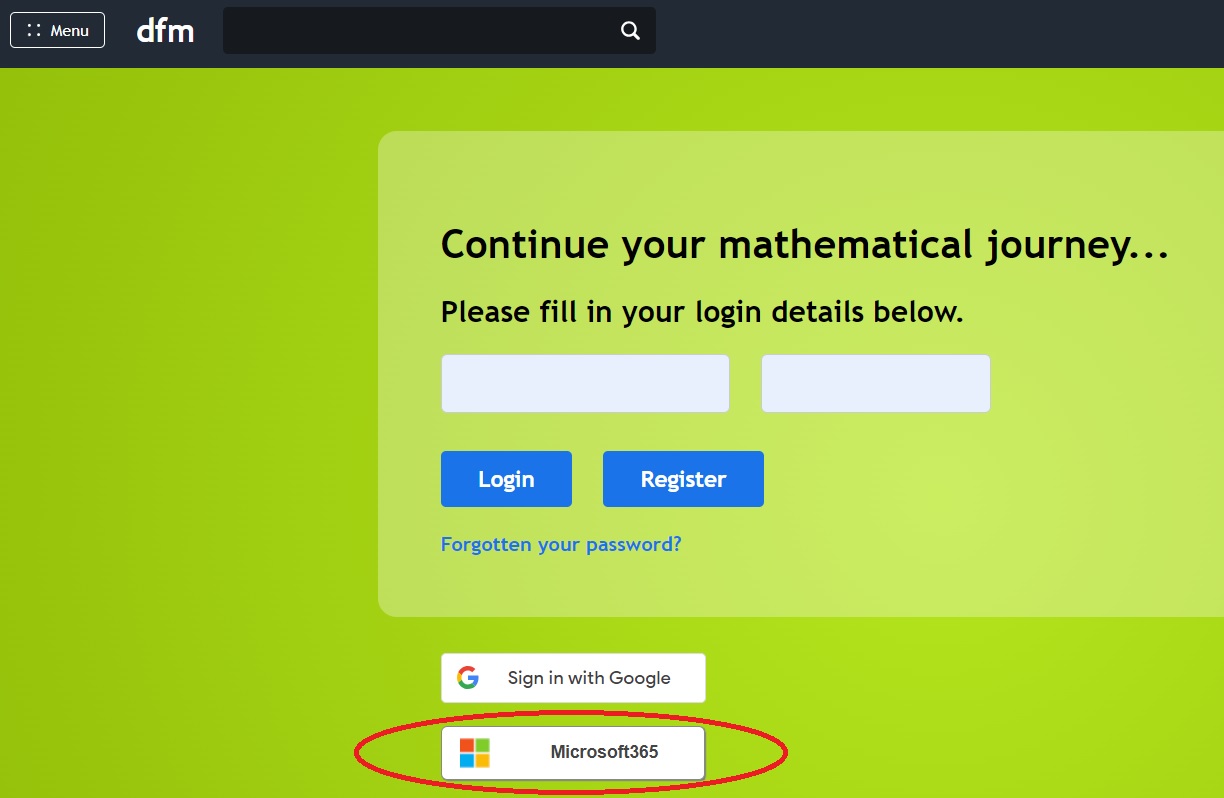
Educake
Some departments use the Educake platform for setting homework for Y7-11. Some students may have been given a username and password for it, but it is easier to log in using single-sign-on as you do for other systems. Click on the 'Log in with Microsoft' button. If you are already logged into your school Microsoft account, it will get you straight in. If not, you will be prompted for your Microsoft credentials.
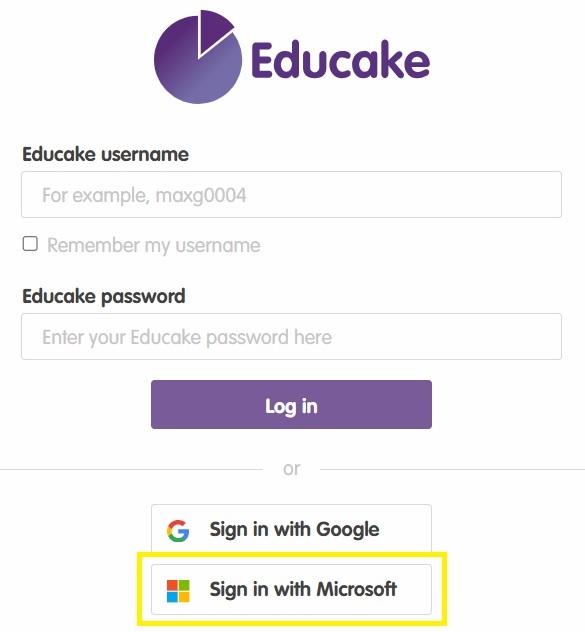
Carousel
Carousel is a tool that some teachers use to create quizzes or online question banks and students use it for revision. Students don't need to create an account for this, they just follow links given to them by their teacher when they set their homework.
Pearson Active Learn
The Spanish department uses Active Learn for homework. The school creates the accounts. The username format is 21bloggs.j. Teachers will give students the password.
Seneca
Students have free access to Seneca - a revision platform. The website covers exam-board specific courses, condensing what students need to know and helping to identify gaps in learning. For instance, when you get a question wrong, the platform will repeat the topic in different formats. Some teachers will set homework on Seneca.
Students can log into Seneca using their school email address and the password that they created when they first set up the Seneca account in class. If the password has been forgotten, please speak to your teacher.
Individual teachers may give students a class code, to attach to their Seneca accounts, so they can monitor learning e.g. for History, the Key Stage 3 code (for year 7-9) is mNdZ-o9kp and the Key Stage 4 code (for year 10-11) is jqn_NVNTV.
Seneca Parent Accounts: If a teacher invites parents/carers of students in their class to monitor Seneca revision (optional), then you will receive an email that includes a link to set up the account. It already knows your email address, so you only need to set a password.

If you have multiple children, you can use the same Seneca parent account for all of them. If you have trouble linking your parent account to your child's account then see this guidance.
After the parent account has been opened, the 'forgotten password' link on the log in page can be used to reset the password whenever necessary.
Please note that:
Seneca may display marketing material to parents, including adverts for premium services and tutoring, so you may wish to review your account's notification and marketing settings.
Teachers may configure homework on Seneca a few days before they assign it to their classes via Bromcom. The due date will be specified on Bromcom when the homework is assigned.
If you prefer not to set up a Seneca parent account, but keep getting email reminders, we suggest you use the "unsubscribe" link at the bottom of the email.
Focus on Sound
The Music department uses an application called Focus on Sound. Students will be told by their music teacher if their class has been set up to use it. To log in, students type the school name, then enter the credentials for their school Microsoft account (see above).
Sparx Reader
All KS3 students use Sparx Reader within English lessons and for homework. Sparx is an excellent platform that rewards students for reading for pleasure. Students can login easily by clicking the purple 'log on with Microsoft' button, and using their usual school email and password.
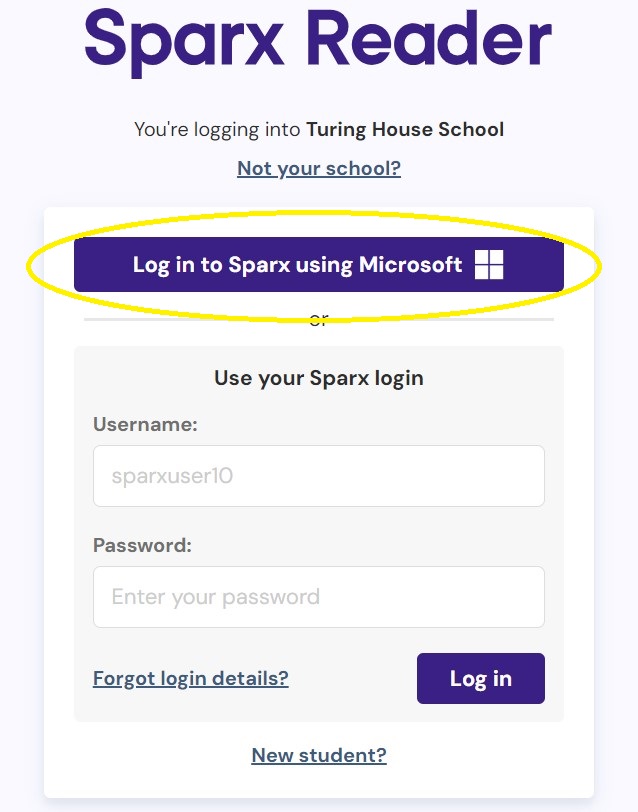
Doddle
Doddle is used by the Science department, particularly in Sixth Form. Teachers can set flipped learning, homework or revision tasks using this platform.
Student usernames for this are of the form JoeBloggs21 (with the number representing the year the student's cohort joined Year 7 - in this case 2021). All accounts log in using the same password, which is 'turing'.
UNIFROG
Unifrog is a careers guidance app, which gives tailored support to students choosing their next steps after school. All students will be invited to set up an account, usually in Year 7, unless they join the school later. The student's Welcome email will go to the student's school email account and they will need to click on the link, then follow the instructions to set their own unique password.
At the same time, parents will receive a letter providing information about Unifrog. It will contain a code that will allow parents to set up their own Unifrog account, so they can explore it from the perspective of a student.
PARALLEL
Parallel is a website created by the popular science author Simon Singh. It offers students a chance to explore some extra maths each week, as an optional extension activity, building on the work done in the classroom. It is completely free, and includes:
- a weekly maths problem sheet, known as a Parallelogram;
- live online
maths circles, where students can learn from some of the best maths educators in the world;
- programmes
tailored to each age group, from 10 to 16 years old;
- awards, certificates and diplomas to students who
complete Parallelograms and attend Maths Circles
There is no obligation to get involved, but we think this is a great opportunity for keen maths students to stretch themselves and explore mathematical concepts beyond the classroom. It is also ideal for students who want to go on to study science or engineering.
Accounts can be created by students or parents by following the instructions on the website. There is no need to enter a Teacher Code unless your child's maths teacher has given them one.
Parent Applications:
ParentPay
We use ParentPay for collecting payments from parents, including for school meals and trips. In order to set up an account for the first time parents will need to refer to the activation email sent to them by the school. If you have lost this, please contact the school office.
StudyBugs
We encourage parents to use StudyBugs to report a student's absence from school, as it is more efficient than emailing or telephoning. You can set up and manage your own account for this, and there is a handy app available for your phone too (just search for Study Bugs in your usual app store).
SchoolCloud (PArents Evenings)
Parents use SchoolCloud to book and attend virtual Parents' Events. There will be information about how to do this in the parents' evening invitation but, in the meantime, you can follow this link to a short video explaining how it works. In secondary school it is usual for children to attend the meetings with their parent, though this is optional. If another parent/guardian would like to join the meeting from another location, you can send them an invitation from within the system.
Involve Education for Performing Arts
Involve is a timetabling application that is integrated with Bromcom. It is used to schedule music lessons for students who learn an instrument during the school day.
General Information:
Managing Passwords:
Unless you have a very good memory, you will need a secure way to manage your passwords. Please do not write them down. You may want to use a password manager. If you have a personal Google account you may already use Google Password Manager, but this isn't secure if others can gain access to your Google account (for example if you leave your account logged in on a shared computer). If you store your password list in an electronic document, for example in MS Word or Excel, you should make sure the document itself is password protected or located in a secure folder. You may find these Microsoft account security tips useful.
Please choose secure passwords, never share them with each other, and do not re-use school network passwords when creating passwords for other systems. A good resource for choosing a password is Dinopass (select the strong password option).
Where to Get help:
Microsoft account help: Our IT network support staff can help to resolve Microsoft username and password issues. Your child can seek their help within school. Parents can only contact them by email via the school office, putting "FAO IT Support" in the email subject line. For password re-sets, students will need to speak to their IT teacher or visit the IT Support office in person.
Other applications: please contact a relevant staff member via the school office, e.g. the school's administrative team will be able to help with BromCom, your child's math teacher will be able to help for Dr Frost Maths, or their form teacher can help with Unifrog.
Important: It will help people to understand the problem if you describe exactly what steps you or your child took before the issue occurred, what device you/they were using, and attach screenshots and/or include the text of any error messages.
